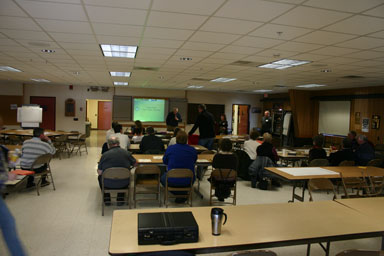March 3, 2007
County seeks budget input
This morning the County held a somewhat unusual information meeting at the Dryden Fire Station, looking for input on residents' priorities for the county budget. It was a long meeting - a bit over three hours long - but it was a lot more information than I've seen before, presented in a mostly understandable format. (Dealing with percentages before 11:00am on a Saturday isn't my usual idea of fun, but it was good.)
The one large problem was turnout. There were a lot of people there, but most of them were either county legislators or county employees. About eight people turned up who weren't otherwise affiliated, and they included a number of current and former elected officials.
After a brief introduction from Legislator Mike Hattery, County Administrator Steve Whicher gave a presentation on the expense side of the budget.

Legislator Mike Hattery introduces the session.
I learned a fair amount about what the county does. I knew they had health and human services, education and library, highway and infrastructure, and public safety services, but I didn't know, for instance, that:
The County administers the civil service exam for local municipalities, BOCES, and school districts.
The County Attorney's office, not the District Attorney's office, is responsible for prosecuting juvenile offenders.
The County Office for the Aging offers a Personal Emergency Response service.
The County's youth services program isn't a youth bureau, like the City of Ithaca Youth Bureau. It's also not about recreation, but rather about prevention services for youth, though its programs mix at-risk children with other children.
The Highway Department manages 307 miles of roads and 109 bridges - all the bridges outside of the City of Ithaca.
The County guarantees the property taxes for the towns, villages, and school districts, ensuring that they get their money even if taxpayers are delinquent.
Two groups did exercises where we used dots to prioritize our interests in county spending. I didn't think the categories made sense, and most of the shifts I might make were inside the category boxes, but the conversation was good.

A group presents on their priorities.
After talking about priorities, Steve Whicher presented again on tax burdens. He included statistics specific to Dryden, which I think are worth exploring.
In the Village of Dryden, for property taxes:
61% of taxes are school taxes
17% of taxes are village taxes
17% of taxes are county taxes
4% of taxes are town taxes
1% of taxes are special district taxes
In the Town of Dryden, in the Dryden School District:
71% of taxes are school taxes
20% of taxes are county taxes
5% of taxes are special district taxes
4% of taxes are town taxes
For residents in the Ithaca schools, the school tax rate is lower. Whicher guesstimated 65% of property taxes there would be school taxes, and the other numbers would be slightly higher as a result of that shift.
Whicher explored the $71 million local share of the budget, 48% of which is raised through property taxes. I'll come back to this when the slides he presented are available on the web, because there's too much information to present simply, and I'm not sure that the presentation he gave was clear. (A key problem is including the capital budget in government operations, which makes it hard to tell how much of that goes to particular departments.)
Next, he explored some hypothetical situations ranging from maintaining all services to increasing spending only on mandates, ranging (hypothetically) from 1.4% to 10% increases in the tax levy. Then we had to go back into our groups and talk about how much of an increase was acceptable. The two groups' consensus figures were 3.4% and 4%, but there were fewer people there at that point and some people whose (higher) input came in after the consensus number was on the chart.
I don't think all of the exercises made sense, but it was still a good conversation. I hope that legislators will look at the specific comments, and not at the dots, as they build the budget. (It definitely felt better than the meeting held for the Route 13/366 Corridor study, with a lot more opportunity for conversation and details comments.)
They'll be having two more similar meetings, with one in Enfield next Saturday and one in Ithaca on March 24th.
Posted by simon at March 3, 2007 2:12 PM in public financeNote on photos
Thanks for the description. It sounds worthwhile, and I'm sorry I missed it. Did the group come up with 3.4-4% because they were considering cost of living? Or was it random? And can you talk more about the special district taxes? Are they the same throughout Dryden (outside of the villages)?
The group number was kind of cost-of-living, kind of random, and another member put up a 10% after we'd done the group calculation.
On special districts, I think they took the tax levy for the town as a whole, which is distorting. Water and sewer districts cost a lot to a few residents, while the ambulance district and fire district are spread out over a lot more residents.
The fire and ambulance taxes are mostly the same throughout the town, except around McLean, which is in its own fire district. The water, sewer, and lighting districts only apply to the places that get those services.
Like nearly everything they presented, finer breakdowns would have been nice, but these are good numbers to think about.